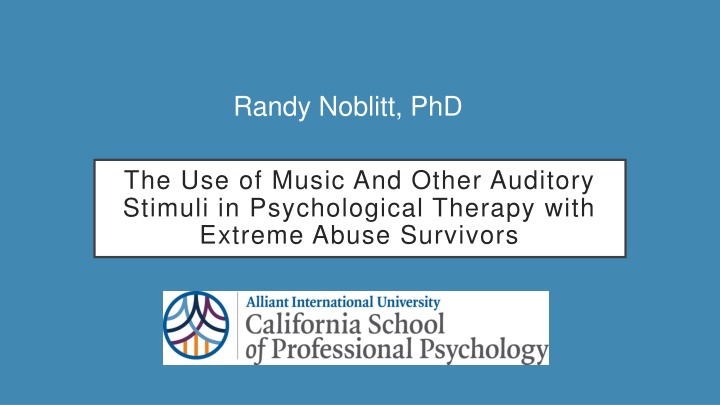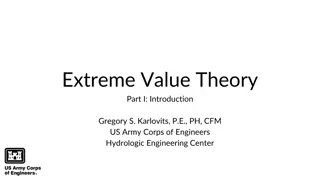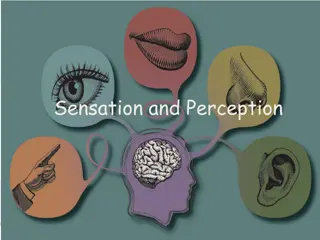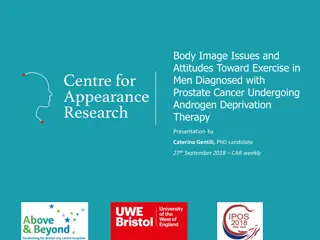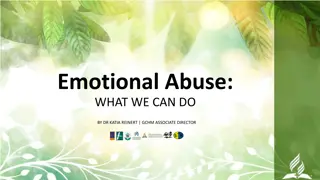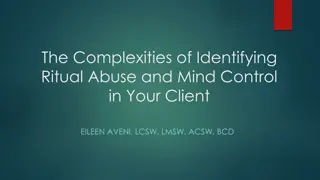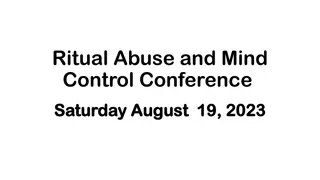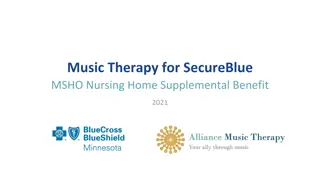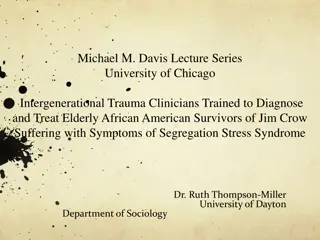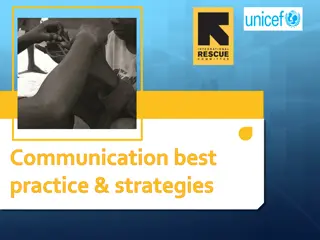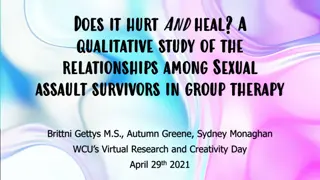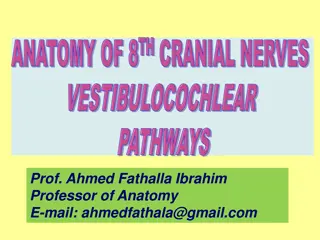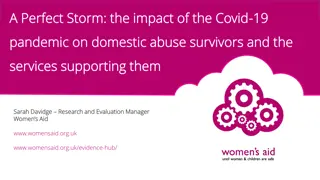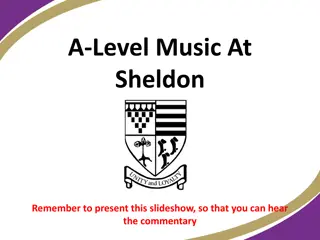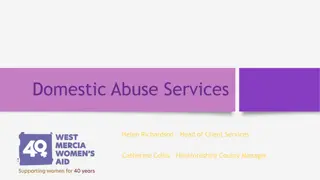The Use of Music and Auditory Stimuli in Psychological Therapy with Extreme Abuse Survivors
Extreme abuse survivors often find solace and emotional regulation through music and other auditory stimuli, which can evoke various responses such as containment, identity switching, and flashbacks. Despite being less discussed in clinical literature, these stimuli play a crucial role in therapy with survivors following the ISSTD's three-stage treatment model for dissociative identity disorder. The treatment model encompasses safety establishment, trauma memory integration, and identity rehabilitation. Safety planning, symptom management, and specific interventions for DID patients are highlighted as key components in therapy.
Download Presentation

Please find below an Image/Link to download the presentation.
The content on the website is provided AS IS for your information and personal use only. It may not be sold, licensed, or shared on other websites without obtaining consent from the author.If you encounter any issues during the download, it is possible that the publisher has removed the file from their server.
You are allowed to download the files provided on this website for personal or commercial use, subject to the condition that they are used lawfully. All files are the property of their respective owners.
The content on the website is provided AS IS for your information and personal use only. It may not be sold, licensed, or shared on other websites without obtaining consent from the author.
E N D
Presentation Transcript
Randy Noblitt, PhD The Use of Music And Other Auditory Stimuli in Psychological Therapy with Extreme Abuse Survivors
INTRODUCTION Extreme abuse (EA) survivors often listen to music for enjoyment, relaxation, and emotion regulation.
INTRODUCTION Some music and other auditory stimuli also have the capacity to trigger a variety of responses including states of adaptive containment being shut down identity switching abreactive responses trance automatisms flashbacks
INTRODUCTION Although clinicians who work with survivors often hear about, or observe these phenomena, there is little discussion of them in the clinical literature. This presentation will discuss some of the uses for music and other sounds in therapy with survivors in the context of the ISSTD s three stage treatment model for dissociative identity disorder.
ISSTD TREATMENT GUIDELINES (2011) The three phase treatment model: 1. Establishing safety, stabilization, and symptom reduction; 2. Confronting, working through, and integrating traumatic memories; and 3. Identity integration and rehabilitation. (ISSTD, 2011, p. 135)
ISSTD TREATMENT GUIDELINES (2011) Some hospital systems require that all patients develop personal safety plans that enumerate factors that tend to ameliorate or reduce the their ability to maintain their safety. For DID patients, these may include listing idiosyncratic posttraumatic triggers as well as measures that provide soothing and comfort.
ISSTD TREATMENT GUIDELINES (2011) Specific interventions for DID patients might include accessing helper alternate identities, using imagery to find an inner safe place for overwhelmed or self-destructive alternate identities, and using imagery to dial down or otherwise attenuate strong affects. (ISSTD, 2011, p.
SAFETY ISSUES AND SYMPTOM MANAGEMENT Safety issues and symptom management should be addressed in a comprehensive and direct manner. Other treatment issues may need to be put on hold until safety is established. Interventions should include (a) education about the necessity for safety for the treatment to succeed; (b) an assessment of the function(s) of unsafe and/or risky behaviors and urges; (c) development of positive and constructive behavioral repertoires to remain safe;
SAFETY ISSUES AND SYMPTOM MANAGEMENT (CONTINUED) (d) identification of alternate identities who act unsafely and/or control unsafe behaviors; (e) development of agreements between alternate identities to help the patient maintain safety; (f) use of symptom management strategies such as grounding techniques, crisis planning, self-hypnosis, and/or medications to provide alternatives to unsafe behaviors; (g) management of addictions and/or eating disorders that may involve referral to adjunctive specialized treatment programs;
SAFETY ISSUES AND SYMPTOM MANAGEMENT (CONTINUED) (h) involvement of appropriate agencies if there is a question about whether the patient is abusive or violent toward children, vulnerable adults, or others (following the laws of the jurisdiction in which the clinician practices); (i) helping the patient with appropriate resources for self-protection from domestic violence; and (j) insisting that the patient seek treatment at a more restrictive level of care, including hospitalization, as necessary to prevent harm to self or others (Brand, 2002). (as cited in ISSTD, 2011, pp. 136-137)
ORGANIZED ABUSE, EA, RA, MC A substantial minority of DID patients report sadistic, exploitive, and coercive abuse at the hands of organized groups. This type of organized abuse victimizes individuals through extreme control of their environments in childhood and frequently involves multiple perpetrators. It may be organized around the activities of pedophile networks, child pornography or child prostitution rings, various religious groups or cults, multigenerational family systems, and human trafficking/prostitution networks. (as cited in ISSTD, 2011, p. 168) What is meant by substantial minority No research is cited.
ORGANIZED ABUSE, EA, RA, MC There is a divergence of opinion in the field concerning the origins of patients reports of seemingly bizarre abuse experiences such as involvement in occultist or satanic ritual abuse and covert government sponsored mind control experiments. (as cited in ISSTD, 2011, p. 169). The Treatment Guidelines state that some professionals believe the allegations of bizarre abuse (RA and MC) and others do not, but they cite no empirical evidence. The most recent comprehensive review of empirical literature shows that in most studies, helping professionals believe that RA/MC is plausible, but not necessarily true in every alleged case. (Noblitt & Noblitt, 2014). Rarely do helping professionals believe that allegations of ritual abuse are always false.
STAGE 1: ESTABLISHING SAFETY, STABILIZATION, AND SYMPTOM REDUCTION There are unique challenges in establishing safety, stabilization, and symptom reduction for RA/MC clients. First, clinicians need to know whether their dissociative clients have a history of RA/MC. RA/MC clients do not always reveal this information at the beginning of treatment. They have been taught to be amnestic about their abuses, and when they clearly remember, they do not typically report the RA/MC until a strong and trusting alliance is established.
STAGE 1: ESTABLISHING SAFETY, STABILIZATION, AND SYMPTOM REDUCTION RA/MC poses unique problems: 1. Clients fear that if they tell the secrets they will be punished. But how can they recover if they don t tell their abuse stories (e.g., in phase 2)? 2. RA/MC survivors can be vulnerable to re-abused by their previous or new abuser groups. How can survivors recover if they are being re-abused?
DELIBERATELY TAUGHT VS. ACCIDENTALLY LEARNED TRIGGERS
GETTING INFORMED CONSENT Use standard informed consent plus May I explore your mind in ways that I do not fully explain in advance, in order to avoid putting ideas in your mind or leading you? If you had a lockbox in your mind with your secrets, would I have your permission to try and open it?
BEGINNING THE EXPLORATION OF MUSIC AS A POSSIBLY STABILIZING TRIGGER Do you ever listen to music? Are you able to relax while listening to music? Are there particular pieces of music that you listen to? Can you bring some of the music that helps you feel more relaxed and comfortable? more relaxed and mentally present? Does some music make you feel stressed? What music does that? Does some music make you feel spacey? What music does that?
BEGINNING THE EXPLORATION OF MUSIC AS A POSSIBLY STABILIZING TRIGGER Begin with the music that helps the client feel relaxed and mentally present. This music can be played through an iPod on an iPod player or CD player in the background while you talk. Watch for any unusual reactions Do you know how to identify trance? Do you know how to identify switching? automatisms, relaxation response, etc.? If you suspect that a particular piece of music is producing a reaction, put it in a repeat mode, and watch for unusual reactions. If you have an uncertain or ambiguous response, ask the survivor to free associate to the music or while the music is playing.
BEGINNING THE EXPLORATION OF MUSIC AS A POSSIBLY STABILIZING TRIGGER Once you have played the music without adverse effects see what happens when you play it while the survivor is talking about upsetting material. Does this music bring your client out of overwhelming or distracted states? If yes, and if this works consistently, you may have found the brakes. There are other common ways to bring clients out of overwhelming or distracted states. Find well-adjusted child alters and learn how to bring them out.
EXPLORING AUDITORY TRIGGERS GENERALLY Sounds Rhythmic Rhythm machine (Casio or similar variety) Metronome (Try using 3 different metronomes simultaneously at slightly different speeds.) Speech Deep, deeper is a common triggering word. Use it repeatedly in a sentence. For example, You seem worried that you are getting deeper and deeper in debt. Play a recording of children saying the Pledge of Allegiance. Play the recorded poem Thoughts on a Gray Day from the Fleetwood Mac Bare Trees Album. Speech in a foreign language
EXPLORING AUDITORY TRIGGERS GENERALLY Recorded music Generally triggering music: Frere Jaques (preferably sung by children) Handel: Hallelujah Chorus (part of Foundling Hospital Anthem) The Beatles: Revolution 9, Today is your Birthday, Back in the USSR, A Day in the Life, She s Leaving Home, Your Mother Should Know Mel McDaniel: Baby s Got her Bluejeans on Rainbow Connection (From The Muppet Movie/Soundtrack Version) Kenny Rogers: Return to Pooh Corner
EXPLORING AUDITORY TRIGGERS GENERALLY Recorded music Generally triggering music: The Beach Boys: In My Room (followed by the German version) Lady Gaga: Telephone Alice Cooper: Years Ago / Steven John Denver: Grandma s Feather Bed Emmylou Harris: Where Will I Be?, Deeper Well Judy Garland: Munchkinland, We re off to See the Wizard Fleetwood Mac: Crystal, Landslide Joan Osborn: Man in the Long Black Coat
EXPLORING AUDITORY TRIGGERS GENERALLY Recorded music: Elton John: Candle in the Wind, Goodbye Yellow-Brick Road Art Garfunkel: Woyawa, Mary Was an Only Child Wilson & Phillips: Where Are You? James Taylor: You ve Got a Friend Eagles: Hotel California Crosby, Stills, & Nash: Guenneviere
EXPLORING AUDITORY TRIGGERS GENERALLY Recorded music: Alan Parsons: Project: Eye in the Sky Smokey Robinson: The Tears of a Clown, The Tracks of My Tears
EXPLORING AUDITORY TRIGGERS GENERALLY Recorded music Generally triggering music: Richard Wagner: Tanha ser, Die Walk re (Ride of the Valkyries) Johannes Brahms: Variations on a Theme by Haydn Renaissance Music: e.g., Saltarello C.P.E. Bach: Keyboard Sonata in B minor Chanting: Gregorian chant Tibetan monks Enigma: Mea Culpa, Sadeness
EXPLORING AUDITORY TRIGGERS GENERALLY Recorded music Generally triggering music: J. S. Bach: Toccata and Fugue in D minor, Mass in B minor Tomaso Albinoni: Adagio in B minor Carl Orff: Carmina Burana (Fortuna, Imperatrix Mundi) National anthems (US, Germany, Israel, Russia, or related to survivor s ancestry) Playing two recordings simultaneously Songs that repeatedly use a person s name: (e.g., Sad Lisa by Cat Stevens; Steven by Alice Cooper, Candy-O by the Cars, Kathleen by Randy Newman)
EXPLORING AUDITORY TRIGGERS GENERALLY Recordings of miscellaneous sounds of Whales, dolphins Passenger trains Cats crying Babies crying Sounds of combat (cannons and small arms firing) Police siren Walking on a floor, climbing stairs, creaky door opening
